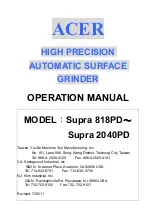
GB
- 20 -
6.2 Battery capacity indicator (Fig. 1c/Item 9)
Press the battery capacity indicator switch (a).
The battery capacity indicator (9) shows the char-
ge status of the battery using 3 LEDs.
All 3 LEDs are lit:
The battery is fully charged.
2 or 1 LED(s) are lit:
The battery has an adequate remaining charge.
1 LED blinks:
The battery is empty, recharge the battery.
All LEDs blink:
The battery pack has undergone exhaustive di-
scharge and is defective. Do not use or charge a
defective battery pack.
6.3 Switching on (Fig. 4)
To switch on, push the On/O
ff
switch (2) forwards
and press it down. To switch o
ff
the angle grinder,
press down the On/O
ff
switch (2) at the back. The
On/O
ff
switch (2) will jump back into its starting
position.
Important!
The equipment will switch to “Standby Mode” af-
ter 10 minutes of non-use.
To reactivate: Switch on the equipment twice or
press the battery capacity indicator.
“Standby Mode” protects the battery.
Important!
Following a stoppage (due to overloading), the
cordless equipment will start up again automati-
cally.
Wait until the machine has reached its top
speed. You can then position the angle grin-
der on the workpiece and machine it.
6.4 Changing the grinding wheels (Fig. 5 / 6)
Use the face spanner (5) supplied to change the
grinding wheels. The face spanner (5) is stored in
the additional handle (3). Pull the face spanner (5)
out of the additional handle (3) when you need it.
Danger!
For safety reasons, the angle grinder
must not be operated with the face spanner (5)
inserted in it.
Warning!
•
Simple wheel change by spindle lock:
•
Press the spindle lock and allow the grinding
wheel to latch in place.
•
Open the flange nut with the face spanner.
(Fig. 6)
•
Change the grinding or cutting wheel and
tighten the flange nut with the face spanner.
Notice!
Only ever press the spindle lock when the
motor and grinding spindle are at a stand-
still! You must keep the spindle lock pressed
while you change the wheel!
For grinding or cutting wheels up to approx. 3 mm
thick, screw on the
fl
ange nut with the
fl
at side
facing the grinding or cutting wheel.
6.5 Flange arrangements when using grin-
ding wheels and cutting wheels (Fig.
7-10)
•
Flange arrangement when using a de-
pressed-centre or straight grinding wheel
(Fig. 8)
a) Clamping flange
b) Flange nut
•
Flange arrangement when using a de-
pressed-centre cutting wheel (Fig. 9)
a) Clamping flange
b) Flange nut
•
Flange arrangement when using a straight
cutting wheel (Fig. 10)
a) Clamping flange
b) Flange nut
6.6 Motor
It is vital for the motor to be well ventilated during
operation. Be sure, therefore, to keep the ventilati-
on holes clean at all times.
6.7 Grinding Wheels
•
Never use a grinding or cutting wheel bigger
than the specified diameter.
•
Before using a grinding or cutting wheel,
check its rated speed.
•
The maximum speed of the grinding or cut-
ting wheel used must be higher than the idle
speed of the angle grinder.
•
Use only grinding and cutting wheels that are
approved for a minimum speed of 8,500 rpm
and a peripheral speed of 56 m/sec.
•
Check the direction of rotation when you use
diamond cutting wheels. The directional arrow
on the diamond cutting wheel must point in
Anl_KX_WS_18_Li_Kit_SPK13.indb 20
Anl_KX_WS_18_Li_Kit_SPK13.indb 20
22.04.2021 12:58:53
22.04.2021 12:58:53
















































